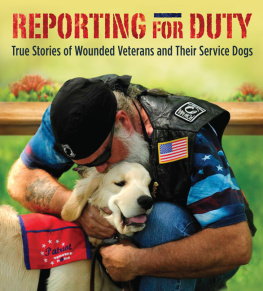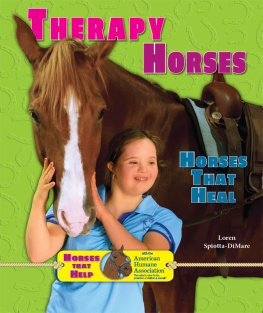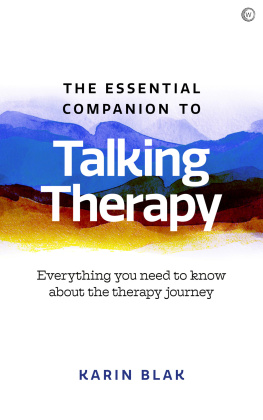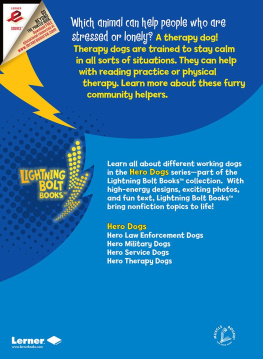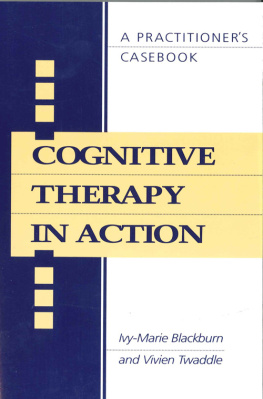
Therapy Dogs
Training Your Dog to Reach Others, 2nd Edition
Kathy Diamond Davis
Dogwise Publishing
A Division of Direct Book Service, Inc.
PO Box 2778
701B Poplar
Wenatchee, Washington 98807
509-663-9115
Website: http://www.dogwisepublishing.com
Email: info@dogwisepublishing.com
Indexing by Elaine Melnick The Index Lady
2002, Kathy Diamond Davis
All rights reserved. No part of this book may be reproduced or transmitted in any form or by any means, electronic or mechanical, including photocopying, recording or by any information storage and retrieval system without permission in writing from the publisher.
Library of Congress Cataloging-in-Publication Data
Davis, Kathy Diamond.
Therapy dogs: training your dog to reach others / by Kathy
Diamond
Davis.2nd ed.
p. cm.
Includes bibliographical references and index.
ISBN 1-929242-05-0
1. DogsTherapeutic use. 2. DogsTraining. I. Title.
RM931.D63 D38 2002
2002004740
Printed in Canada
Table of Contents
In Summary
Acknowledgments
To my dogs, Saint, Angel, Star, Spirit, Gabriel and Believer. Living with them has been a taste of heaven on earth.
To my husband, Bill, for support of every kind and for serving as the model handler for photographs.
To Linda OHare Newsome, for my wonderful Belgian Tervuren and for teaching me so much about training.
To Moira Allen, Seymour Weiss, the wonderful folks at Dogwise and Dr. Carolyn C. Hunt for help and encouragement.
My deep appreciation goes to all the people and families who generously allowed their photographs to be included, in order to provide readers with further insights into the world of therapy dog visits.
To God, for everything.
Kathy Diamond Davis
It has been a privilege to update this second edition of Therapy Dogs: Training Your Dog To Reach Others. Therapy dog volunteers are some of the finest people I know, with the finest dogs. I wrote the book to be of service to these wonderful individuals. I am deeply grateful it has made a difference in so many lives.
Since the first edition, Saint, Angel and Star have completed their therapy dog careers. One at a time, with many tears, I held them in my arms as they left for heaven. Part of the heritage they left is what I can share with you in this second edition.
I have also adopted, raised and trained a puppy who turned out to have an unsuitable temperament for a therapy dog. Spirit, still by my side now as I write, has taught me as much as any of the dogs who have succeeded, and has added many insights to help choose and train therapy dogs.
For two years I taught a therapy dog class, until interest in my community had grown sufficiently for others to take over teaching. Therapy dog classes can fill the need for more volunteers in an area and provide vital support for handlers. This edition includes ideas for classes.
Finally, I have two new therapy dogs, Gabriel and Believer. They have added to my therapy dog training and handling education, lessons I am delighted to have the opportunity to share with you. Thank you for reading, and thank you for your interest in serving your fellow humans with your dog. May therapy dog work bring you as much joy as it has brought to my dogs and to me!
Therapy dogs function to help people primarily in emotional ways, though physical benefits can result by boosting morale for physical therapy as well as self-care tasks. The term therapy dog was used by the first registry in the United States, Therapy Dogs International, for dogs taken on visits to health care facilities. Therapy Dogs Incorporated and a number of other organizations have followed suit. Delta Society dogs are called Pet Partners.
Animal-assisted therapy, animal-assisted activity and pet therapy are all terms that describe the encounter between a therapy dog and a person being visited. I use the term therapy dog visit, which applies even when a licensed therapist is not involved. This book focuses on the job of the volunteer therapy dog handler. Many of us work along with licensed therapists on some visits, while on others we work without these paid professionals to provide benefits to people. Licensed professional therapists and counselors occasionally include dogs in their practice. See appendices for resources.
Therapy dogs have the right to go where they have been invited, including health-care facilities that, until the early 1980s, were legally off-limits to dogs. State by state in the United Statesand in many other countries of the worldlaws have been changed to provide this access for therapy dogs. It is state legislation rather than federal at this time.
Its essential to understand that a therapy dog is not an assistance dog. A dog that assists a person to function with a physical disability is in a different legal category, as well as a different functional one. Terms for these dogs include assistance dog, service dog, hearing dog, mobility assistance dog, guide dog, and others. Assistance dogs for people with disabilities can also include dogs that alert to impending epileptic seizures, as well as a variety of other functions.
The Americans with Disabilities Act gives people with qualified disabilities the legal right to take their trained assistance dogs with them to places open to the public. One term for this is public access rights. Therapy dogs are not included in the Americans with Disabilities Act and do not have federal public access rights under this legislation. State laws vary, and access rights in some states may apply to therapy dogs. It is important that therapy dog handlers not try to exercise public access rights inappropriately, because this behavior harms disabled people who need to exercise such rights with their assistance dogs.
This book will focus on practical instructions for managing, training and handling a therapy dog as part of a human-dog team. People seeking scientific data on therapy dog work can increasingly find it, because research in the field is ongoing. See the appendices for more information.
Careful reading of this book will inform the reader of the potential risks involved in therapy dog work and how to avoid them. Qualified handlers making therapy dog visits with trained dogs rarely cause accidents resulting in injury. Please realize, though, that the author cannot be held responsible for the actions or omissions of others working with therapy dogs. As in every other dog pursuit, each owner/handler must assume responsibility.
Many of the photos were taken by the author while working a dog on volunteer therapy dog visits, and copies were always given to the people pictured. They generally preferred to look at the camera and have the dog also facing the camera, for keep-sake photos.
Language purists will notice the use of the word person when referring to patients, clients, children, participants, residents and others served by facility therapy dog visits. The term patient is considered unacceptable in many facilities when referring to the people receiving care. Such attention to terminology helps staff take seriously the needs, feelings and thoughts of the people they serve.
The term I have used in this book is person, plural people, in spite of the awkwardness in language it sometimes causes. The purpose of language is to serve people. Most of us prefer to be thought of as people first, not labeled according to a disability.
I also regret the necessity of referring to a dog as it when the dog could be of either sex. Be assured, I dont think of
Next page

